Pruning Storm Damaged Trees
Return to Trees and Shrubs Agent Articles
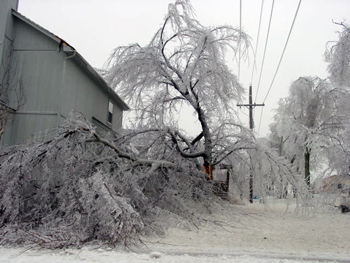 The explosive cracking sounds of trees crashing to the ground are sickening to the stomach. Whether it's damage from ice storms or sudden thunderstorms in the summer, trees require special care and should make a full recovery with little long-term injury.
The explosive cracking sounds of trees crashing to the ground are sickening to the stomach. Whether it's damage from ice storms or sudden thunderstorms in the summer, trees require special care and should make a full recovery with little long-term injury.
Remove debris, then assess the damage
The first step is to make sure that there are no downed power lines or other dangerous elements.
Once you have deemed the area as safe, then the next step in caring for damaged trees is to remove all debris. This is mainly a safety factor, but also enables you to completely assess the extent of the damage.
Can the tree be saved? 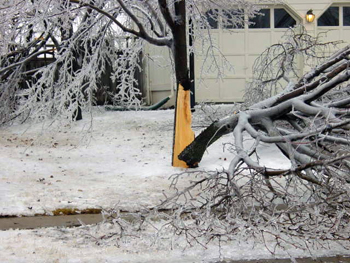 Next, determine whether the tree can be saved. Most trees will be salvageable and will need time to recover. If there is heavy splitting of the bark and the cambium, growth layer is exposed, or the main trunk is split, the tree will probably not survive and should be removed.
Next, determine whether the tree can be saved. Most trees will be salvageable and will need time to recover. If there is heavy splitting of the bark and the cambium, growth layer is exposed, or the main trunk is split, the tree will probably not survive and should be removed.
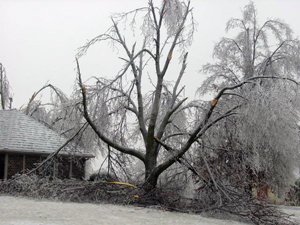 Also, if there are so many broken limbs that the form of the tree is destroyed, replacement may be the best option.
Also, if there are so many broken limbs that the form of the tree is destroyed, replacement may be the best option.
Once it has been determined that the tree can be saved then pruning begins. Broken branches should be cut back to the next larger branch or back to the trunk. Never leave a stub when making a pruning cut. Stubs lead to rot and decay, and slow the healing process.
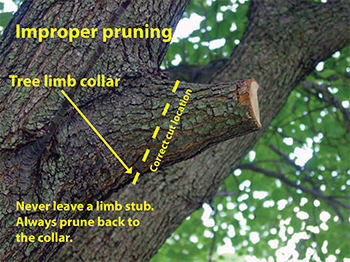 When cutting back to the next larger crotch or branch angle, do not cut flush with the branch. Instead make the cut in the area referred to as the branch collar. The collar is a transition area between the branch and the trunk. Cutting flush with the branch or trunk leaves a larger wound, which takes longer to heal. The collar area is raised with bark tissue, much like the crease on your hand where your thumb joins the other fingers.
When cutting back to the next larger crotch or branch angle, do not cut flush with the branch. Instead make the cut in the area referred to as the branch collar. The collar is a transition area between the branch and the trunk. Cutting flush with the branch or trunk leaves a larger wound, which takes longer to heal. The collar area is raised with bark tissue, much like the crease on your hand where your thumb joins the other fingers.
Larger limbs should be taken off in stages. Cutting a large branch at once often leads to a strip of bark being ripped from the tree increasing the amount of damage. The following steps to removing large branches are:
- First cut about fifteen inches from the trunk or next larger branch. Start from the bottom and cut about one third of the way up through the branch.
- The second cut should be made from the top down, a few inches out from the first under cut. The branch will break away at the first cut as you make the second cut.
- Lastly, cut the remaining branch at the collar, which can be supported to prevent the bark stripping.
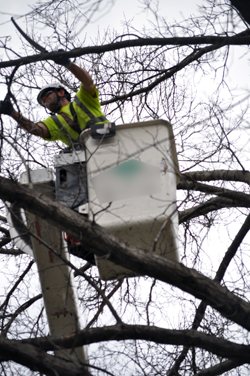 Avoid "door knockers." Hire a local reputable tree company
Avoid "door knockers." Hire a local reputable tree company
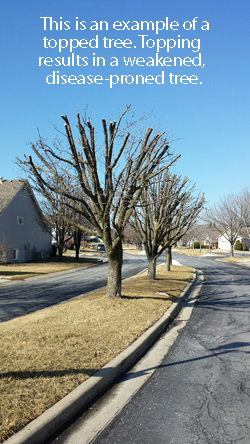 Large trees are best handled by a reputable tree care service. Johnson County is fortunate to have many qualified arborists. When selecting a firm always ask for a certified arborist and never pay in advance. Quality companies will bill or collect after the work is completed.
Large trees are best handled by a reputable tree care service. Johnson County is fortunate to have many qualified arborists. When selecting a firm always ask for a certified arborist and never pay in advance. Quality companies will bill or collect after the work is completed.
Also, never allow the tree care service to use shoe spikes clipped to their work boots to climb your trees. Spikes cause damage, and/or can introduce disease into the tree. Spikes are only acceptable if the tree in question is going to be completely removed.
Topping is not a recommended practice of repairing storm damage. Topping weakens trees and makes them more susceptible to disease. If the damage is this severe then the tree should be removed. Also, no wound dressings are needed.
By taking the proper steps now the life and structure of the tree can be greatly improved for a full life.
Resources for Selecting a Reputable Tree Service
- How to Contact an Arborist
- Selecting a Certified Arborist in Kansas
- Verify an ISA Certification / Find a Tree Care Service
Have questions? The Garden Hotline is staffed by trained EMG volunteers and Extension staff who will assist you with questions.
Phone: (913) 715-7050
Email: garden.help@jocogov.org